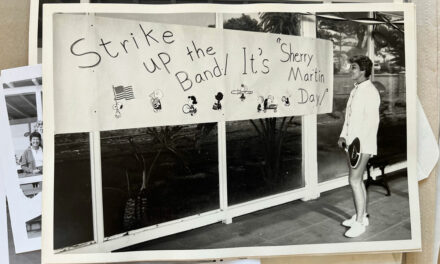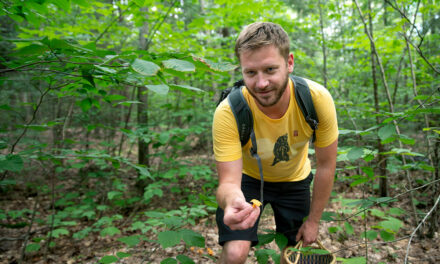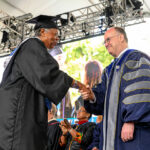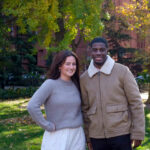
Life in the Fast Lane
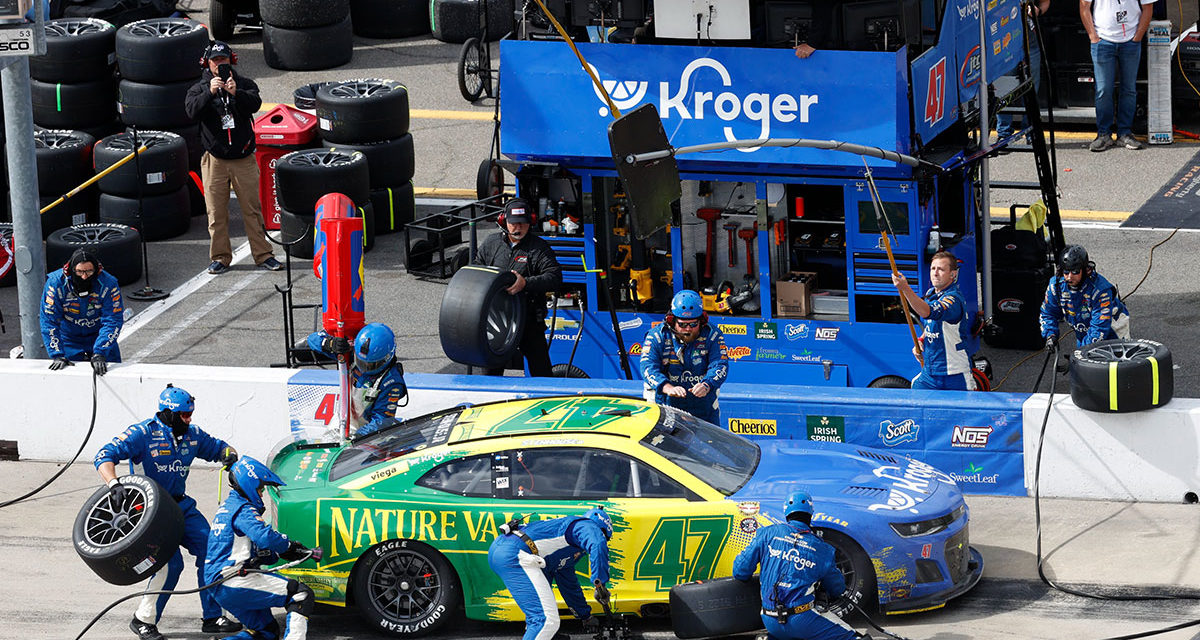
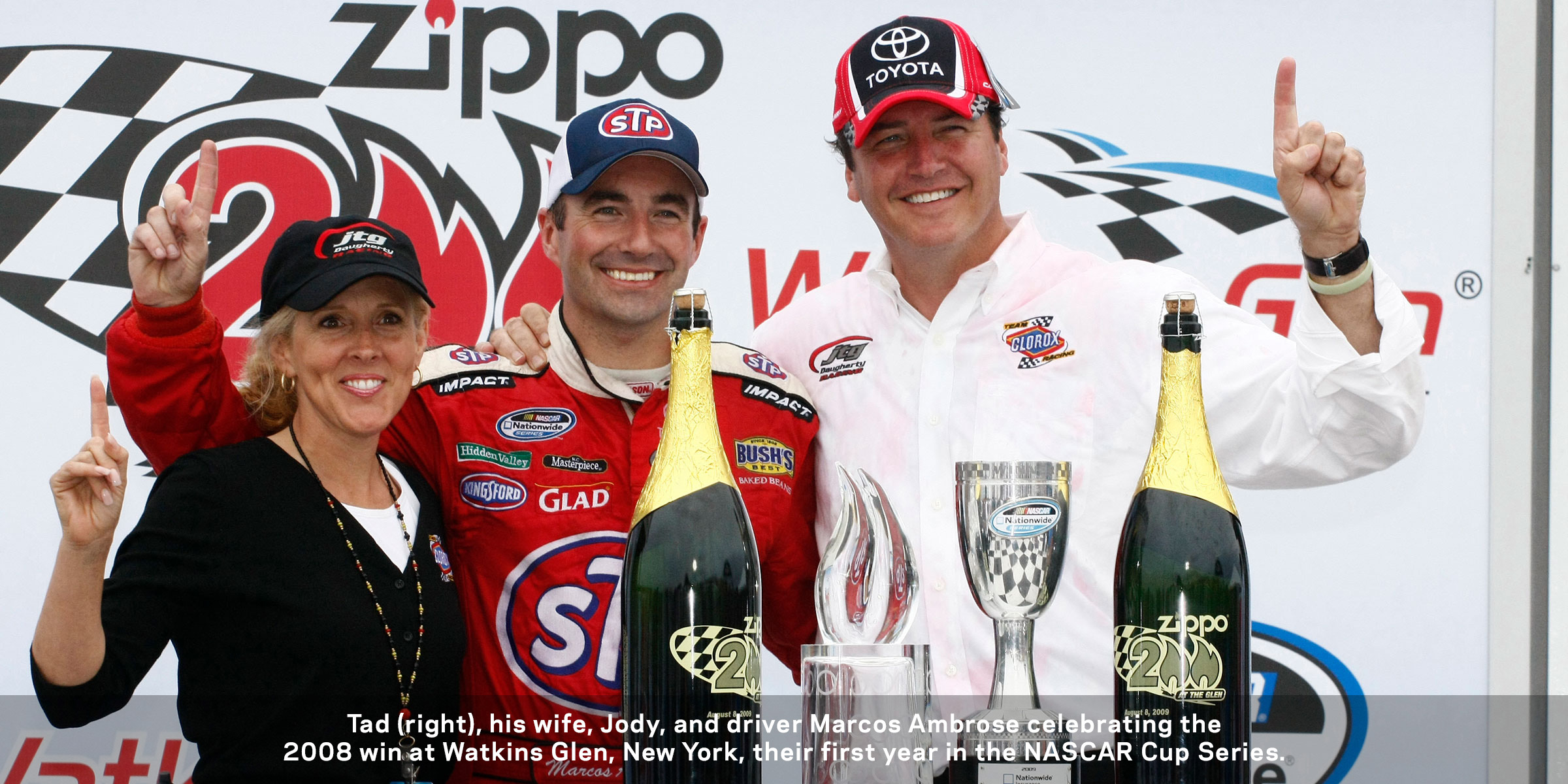
Life in the Fast Lane
Tad Geschickter ‘81 deals in fractions of a second
BY JESSICA YARMOSKY
Tad Geschickter is so disarmingly polite and soft-spoken that it’s almost hard to believe he once held one of the most stressful jobs in the world: in the pit crew for NASCAR.
For a few hours—the time it takes the cars to race 500 miles around and around a track—Tad had to be on alert, ready to move with less than a second’s notice. While one crew member hauled a 20-pound jack to lift the car up for a tire change, another had to position a gas hose at just the right location—down to the centimeter—to be able to quickly fill the car’s tank. Others replaced tires and quickly repaired any damage the car had sustained while flying around the track at up to 200 miles per hour.
“I tell people the difference between first and second in a race is often less than two tenths of a second,” Tad says. “So we’re running 500 miles, and at the end, it comes down to two tenths of a second.”
One faulty move in the pit, one stray elbow out of place, or one tool a centimeter off track could mean the difference between a win and a loss. “We’re competing on fractions of a second,” he says.
Read Tad’s page in the 1981 St. Stephen’s yearbook and you might not guess at the underlying intensity and drive he has for competition. A three-sport athlete, he’s described on his page as a “nice guy,” a “hard worker,” and “innocent.” Three terms you might not expect for someone who’s spent the majority of his career working in the cutthroat, high-drama world of NASCAR.
“It’s literally the most competitive sport on the planet,” Tad says.
And if it wasn’t for the foundation he built as a Saint, his athletic prowess off the racetrack, and, in his own words, “one miracle after another,” he might never have experienced it.
“I Thought I’d Give it a Try”
Tad, who joined the Saints community in seventh grade, thought he had his life pretty much planned out. While he considered entering the priesthood at one point during his time at St. Stephen’s, his plans shifted as graduation loomed. Instead of the seminary, Tad decided he’d go to college and study to be a teacher and a coach; this dream was heavily influenced by the relationships he made at the school while playing football, basketball and baseball.
“Everything I loved about St. Stephen’s, a lot of it centered around the teachers who I became close with, and the coaches I played for,” he says. “I always thought it would be fun to go back and coach there one day, and teach there.”
After graduating in 1981, Tad went on to the College of William and Mary and joined the school’s Division 1 baseball team. While Tad flourished on the baseball diamond, his coach was eyeing him for another opportunity. Tad’s coach, who was also a professor on campus, had a good relationship with Procter & Gamble recruiters. Two months before graduation, Tad got a call out of the blue. He was asked to come in for an interview.
The six-week interview process was arduous. “I had never considered a career at a company like that,” Tad says, “But [I thought the interview process] would be a fun thing to do.” Two weeks before Tad’s graduation from William and Mary with his degree in physical education and kinesiology, Procter & Gamble offered him a sales job in Knoxville, Tennessee.
For someone who’d long had his career planned out, Tad says the job offer turned his world upside down. Still, there were definite perks—like the starting salary.
“I was pretty broke finishing college,” Tad says. “So I thought, well, I can always go back to teaching and coaching, because I’ve got my degree and my certificate. But I thought I’d give it a try.”
That “try” turned into ten years at Procter & Gamble, rising through the ranks of sales management across the Southeast U.S. and winning multiple awards for being one of the company’s top sales managers.
If not for what happened next, Tad might have stayed with the company until he retired. But once again, an opportunity came knocking that pushed Tad off his pre-planned track: Procter & Gamble started looking into sponsoring NASCAR cars.
At the time, all of NASCAR sponsorships were for roughly three things: cigarettes, motor oil, or automotive products. For a consumer products company like Procter & Gamble to sponsor a car was almost unheard of.
According to Tad, NASCAR’s fan base is second in number only to the NFL, and approximately 40 percent of NASCAR fans are female, Tad explained. If Procter & Gamble could reach them, they could build brand recognition and loyalty with almost half of what was already a gigantic fan base.
Saintly Facts
Favorite St. Stephen’s event:
Any Saturday football game.
Favorite tradition:
Spring dress. We didn’t have to wear ties. We still had to come with that button-down shirt and slacks, but the ties and the coats came off. It’s the little things, at that age.
Favorite subject:
Theology and English. Mr. Willis Wills and Ms. Frances Owens taught me to write, think critically, and convey my thoughts, and I’m forever grateful for them teaching me how to do that. It’s what kept our company alive, even today. Mr. and Mrs. Wills made the trip to Knoxville for my wedding!
Outstanding memory:
We had a senior lounge, and that was a big deal. I think the times just hanging out in the senior lounge, talking about life with my friends, that was probably my favorite.
Teacher or coach who had a profound impact on you:
Coach Gardiner used to always yell at me on the football field, “Go to your area of responsibility first and work from there.” And we still talk about that on the race team.
How St. Stephen’s prepared you for life in general:
SSS taught me how to socialize and to think critically in a highly competitive environment, and provided the discipline of wanting to compete and not being intimidated by challenges. And boy, when you rise to a challenge, it certainly builds your self-confidence, which serves you well for life.
What kind of car did you drive in high school and what do you drive now?
Went from driving a family station wagon to a Cadillac XT4.
Sponsoring NASCAR is different from sponsoring other professional sports. Tad explained it this way: “If you put your [company] name on the stadium in D.C., people may or may not associate you with the team [that plays there]. If you put your name on a jersey in the NBA, you’re not going to change the name of the team to the Cincinnati Tides. But literally, when you put your name on NASCAR, that’s how people identify the team. It’s the Tide car. Or the Dawn car. So, I was really intrigued.”
Intrigued…but not experienced. He says higher-ups “dumped” the NASCAR sponsorship program in his lap, but there was one issue. “I’d never been to a race,” Tad says. Procter & Gamble didn’t see that as a problem. “They said, we’re gonna spend the money, and we’re gonna figure it out.”
Turns out, that money was well-spent. Tad thrived at the helm, and the company’s NASCAR sponsorship program grew.
At the same time, Tad’s family was growing, too. He married his now-wife, Jodi, and suddenly was at a crossroads. Tad’s position with Procter & Gamble would require the couple to relocate every few years. Jodi, says Tad, “was not intrigued” by that. “She didn’t sign on to be a military wife. So I had to make a tough decision.”
Tad was thirty years old. He could stay with Procter & Gamble, call on the same customer base he’d been calling on for a decade, and, in his words, “quit challenging myself.” Or, he could do something different. He could take a risk.
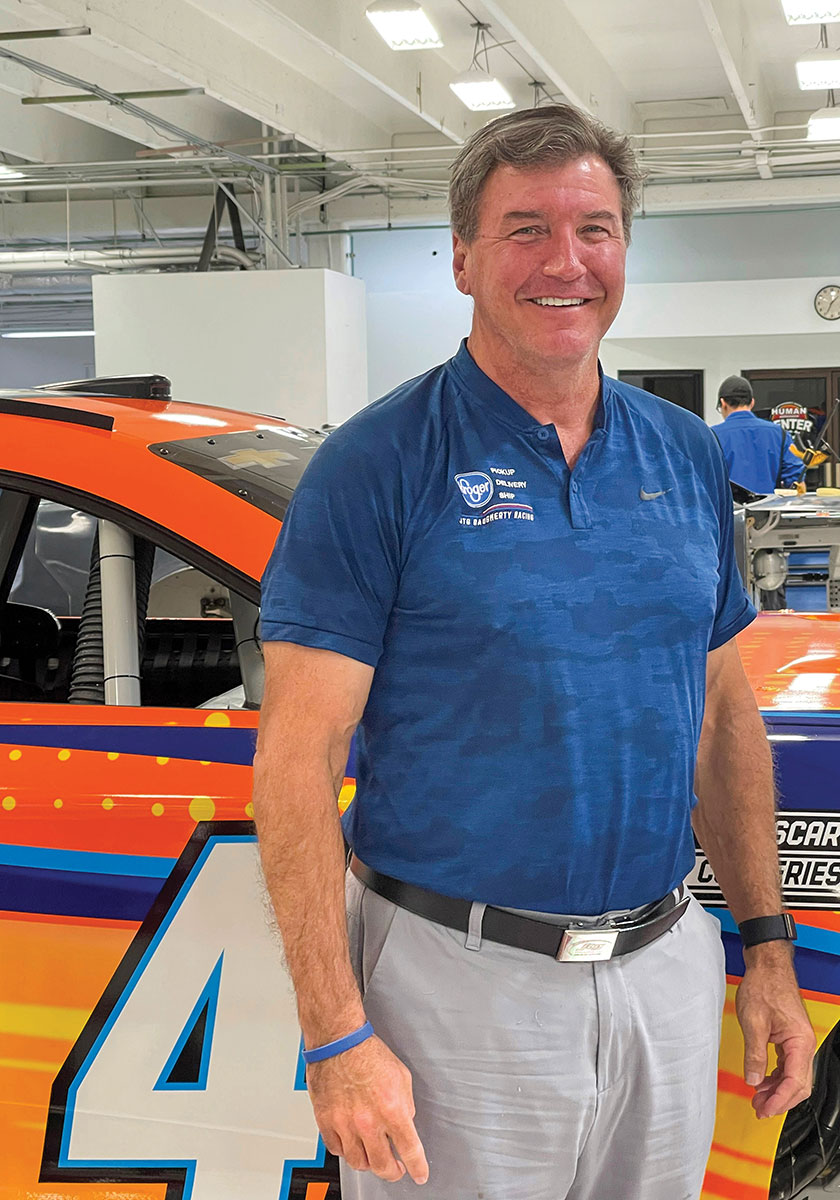
The risk?
Building his own NASCAR team.
Turns out, the idea had roots at St. Stephens and a saying Tad heard from one of the Reverends there—either Reverend Marlin or Reverend Gibson: “Where your God-given talents and your passions collide, that’s your mission field.”
“I loved team sports, and I missed them,” Tad says. “I love sales and marketing. And NASCAR’s the perfect confluence of those two things. So I decidedly naively, well, I understand how sponsorship works. Certainly I can start a race team.”
With wisdom from the Reverends and a sharp skill set from a decade as a sales manager, Tad set out to build a team with Jodi.
Their beginnings were humble, to say the least.
“We started at a barn with dirt floors and a toolbox,” Tad says. “We started dialing for dollars, and taking what we learned at P&G and trying to entice sponsors to come on board and be involved with our team. And the rest is history.”
If “history” sounds easy – think again.
“There were lots of starts and stops along the way,” Tad says. “And lots of ramen noodles during the lean months,” he adds, laughing.
But Tad says their continued success —despite the challenges—is “proof that it’s the Lord’s will that we do it. There’s no way we should have survived this far, and thrived this long. It’s been one miracle after the other, through the years, that has kept us going.”
Tad and Jodi slowly signed sponsors and brought on former NBA player Brad Daugherty as a partner. Tad’s earlier career only helped.
“The uniqueness of what I learned at Procter & Gamble with marketing and sales allowed us to put together a brand that resonated with consumer packaged goods companies and retailers,” Tad says. “So that was really how we grew.”
In 1995 JTG Daugherty Racing debuted at NASCAR’s Nationwide Series at Daytona. The Nationwide Series, now called Xfinity, is considered the “minor league” of NASCAR. For several years, JTG Daugherty raced in that circuit.
In 2004 the company was at a crossroads. They had to decide whether and how to grow and what the future looked like. Tad and Jodi began working with a business consultant, who took them on a retreat to the mountains of Asheville, North Carolina, and had them do what Tad thought was a meaningless exercise. “He gave us a big piece of paper and crayons and said, ‘I want you to draw what your business looks like in 10 years.’ I thought, this is stupid. I can’t draw,” Tad says. But he followed directions and drew a white building with lots of windows and big trees in front among which employees could sit and eat lunch or take a break.
The exercise may have seemed nonsensical at first, but something about it stuck. “If you took a picture of our shop today,” Tad says, “that’s what it looks like.”
“That’s the Special Part”
Today, a barn with dirt floors has become a 130,000-square foot facility in Harrisburg, North Carolina. “Almost every piece of equipment in there,” Tad says, “I can think about the decision we made—do we buy it, or can we live without it?”
In addition to owning a NASCAR team, Tad and Jodi also run Brand Activation Maximizer, which helps brands that want to sponsor NASCAR teams optimize their return on investment.
Since 2008 JTG Daugherty has been racing in NASCAR’s Cup Series—the “major league” of the sport. The series includes 36 races a year at dozens of tracks all over the U.S.
As the facility has grown, so has the company. Besides Tad and Jodi and a few co-owners, JTG Daugherty also employs structural engineers, aerodynamic specialists, mechanics, PR experts, accountants, and fabricators. Oh, and several former college and professional athletes—not to drive, but as part of the pit crew. Those are the folks who have seconds to refill gas tanks, change tires, and repair anything that’s broken multiple times during the 500-mile, three-and-a-half hour races.
Tad says he’s experienced every job possible within JTG Daugherty racing —yes, even the pit crew. For the first few years of the team’s existence, Tad said he figured he was a good enough athlete and could save the team some money. Back then pit stops took 14 seconds, he says. But they were brutally physically demanding. “That’s why I limp around a lot,” Tad says, laughing.
Today, pit crews can get Cup cars through pit stops in about ten seconds, thanks to a deeper understanding of kinesiology. Tad is no longer among them—he’s busy finding and retaining sponsors.
While the team gets some money from winnings and ticket sales, most of JTG Daugherty’s operating costs are paid for by sponsors, in exchange for helping the brands grow their business through the size, scale, and passion of NASCAR fans.
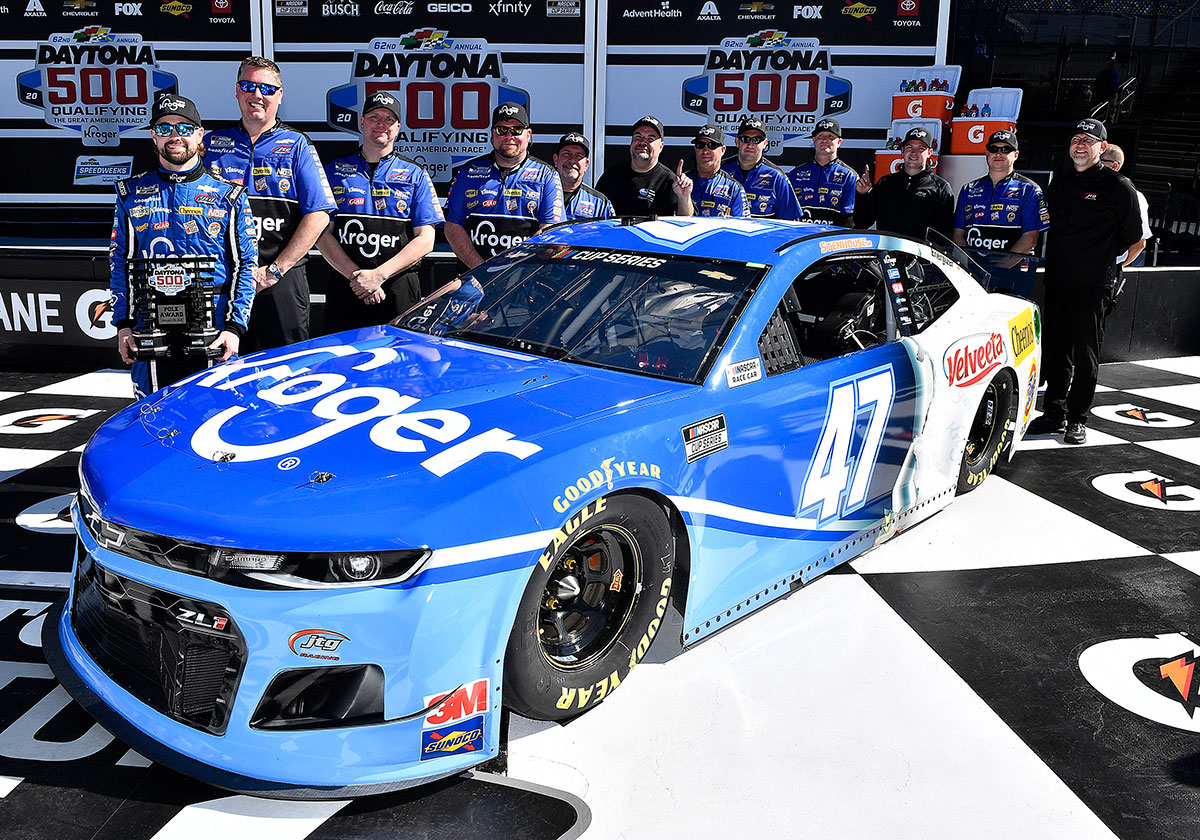
“It’s really fun,” Tad says. “And the critical thinking I learned at St. Stephens is critical now, because I can connect the dots between what a sponsor’s trying to solve for and put together a program that makes sense for them.
“Anytime you get those sponsors, or a renewal from those sponsors,” Tad says, “it’s gratifying and a special day.”
And of course, winning races is gratifying, too. Tad says it reminds him to be grateful for the people he works with.
“I tend to like to step back at Victory Lane and just watch all the people who we’ve lived through births, deaths, baptisms, and Little League home runs together,” he says. “We work seven days a week. So watching them enjoy the fruits, that’s what I really enjoy. That’s the special part.”
Tad’s senior yearbook page in 1981 featured this quote by former professional baseball player Steve Garvey: “If, during your life, you can make this world a better place, not only for yourself, but for your friends and family, then you’ve been a winner.”
Safe to say that even when JTG Daugherty’s car doesn’t cross the finish line first, Tad still feels like a winner.
You can watch JTG Daugherty’s car race in the NASCAR Cup Series on most Sundays through November. Their car, #47, is driven by Ricky Stenhouse, Jr.

